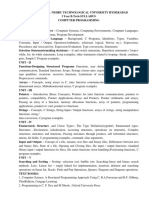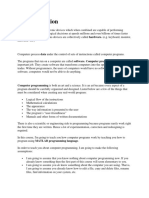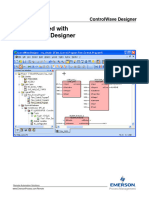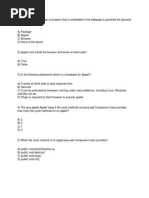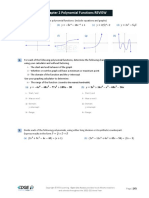CMPE 102 - Module 1 - Introduction to Computers and Programming
Uploaded by
neil roqueCMPE 102 - Module 1 - Introduction to Computers and Programming
Uploaded by
neil roqueCMPE 102
Programming Logic and Design
Module 1
Introduction to Computers and
Programming
1-1
DEPARTMENT OF COMPUTER ENGINEERING
Introduction
• People use computers at…
– School for writing papers, research, email, online classes, etc.
– Work for analyzing data, make presentations, business transactions,
communicating, control machines, etc.
– Home for paying bills, shopping online, communicating, playing
computer games, etc.
What are some of the ways you use
computers?
1-2
DEPARTMENT OF COMPUTER ENGINEERING
Introduction
• Devices that are computers…
– Smart Phones
– iPods and tablets
– Blackberries
– Car navigation system (GPS)
Can you think of some other devices
that are computers?
1-3
DEPARTMENT OF COMPUTER ENGINEERING
Introduction
• Computers are designed to do any job that
their programs tell them to do.
• A program is a set of instructions that a computer
follows to perform a task.
For example: Microsoft Word and Adobe Photoshop
• Programs are commonly referred to as
software.
What software have you used?
1-4
DEPARTMENT OF COMPUTER ENGINEERING
Introduction
• Programmers or Software Developers are the
individuals that create computer software.
• They have the training and skill to design,
create, and test computer programs.
What are some of the fields in
which computer programs are used?
1-5
DEPARTMENT OF COMPUTER ENGINEERING
Hardware and Software
Concept:
The physical devices that a computer is
made of are referred to as the computer’s
hardware. The programs that run on a
computer are referred to as software.
1-6
DEPARTMENT OF COMPUTER ENGINEERING
Hardware and Software
Hardware
• The physical devices that a computer is
made of are referred to as the computer’s
hardware.
• A computer is a system of devices that work
together.
1-7
DEPARTMENT OF COMPUTER ENGINEERING
Hardware and Software
Hardware
A Computer System consists of:
– Central Processing Unit (CPU)
– Main memory
– Secondary storage
– Input devices
– Output devices
Figure 1-2 Typical components
of a computer system
1-8
DEPARTMENT OF COMPUTER ENGINEERING
Hardware and Software
Hardware
Central Processing Unit (CPU)
The CPU is the part of a computer that runs the programs.
Without a CPU a computer cannot run software.
Running or executing a program is the term used when the
computer performs the tasks that the program tells it to do.
1-9
DEPARTMENT OF COMPUTER ENGINEERING
Hardware and Software
Hardware Figure 1-3 The ENIAC computer
(courtesy of U.S. Army Historic Computer Images)
ENIAC
• World’s first programmable computer
• Built in 1945
• Designed to calculate artillery ballistic
tables for the U.S. Army
• CPU was 8 feet tall, 100 feet long, and
weighed 30 tons
Microprocessor Figure 1-4
A lab technician
• Much smaller
holds a modern
• Much more powerful microprocessor
(photo courtesy of Intel
Corporation)
1-10
DEPARTMENT OF COMPUTER ENGINEERING
Hardware and Software
Hardware
Main Memory
• Considered the computer’s work area
• Computer stores the program that is running as well as the data
• Commonly known as the random-access memory (RAM)
• Data is quickly accessed
• RAM is a volatile type of memory
• Used for temporary storage
• RAM is erased when computer is turned off
1-11
DEPARTMENT OF COMPUTER ENGINEERING
Hardware and Software
Hardware
Secondary Storage Devices
• Type of memory that can hold data for long periods of time.
• Programs and important data are stored in secondary storage
• Disk drive is a common type of secondary storage
– Data is stored by magnetically encoding it onto a circular disk
– Most computers have an internal disk drive
– Some have external disk drives; they are used to create backup copies
• Floppy drives record data onto a small floppy disk
– Holds only a small amount of data
– Slow to access data
– Can be unreliable
1-12
DEPARTMENT OF COMPUTER ENGINEERING
Hardware and Software
Hardware
Secondary Storage Devices
• USB drives are small devices that plug into the computer’s universal serial bus
(USB) port
– It does not contain a disk
– The data is stored on flash memory
– Also known as memory sticks and flash drives
– Inexpensive, reliable, and small
• Optical devices (CD or DVD)
– Data is encoded as a series of pits on the disc’s surface
– Uses laser to encode the data
– Holds large amounts of data
– Good medium for creating backups
1-13
DEPARTMENT OF COMPUTER ENGINEERING
Hardware and Software
Hardware
Input Devices
• Any data the computer collects from people and from other
devices is called input.
• The hardware component that collects the data is called an
input device.
• Common input devices are:
– Keyboard
– Mouse
– Scanner
– Microphone
– Digital camera
Can you think of any other input devices?
1-14
DEPARTMENT OF COMPUTER ENGINEERING
Hardware and Software
Hardware
Output Devices
• Any data the computer produces for people or for other
devices is called output.
• The hardware component that formats and presents the
data is called an output device.
• Common output devices are:
– monitor
– Printer
Can you think of any other output devices?
1-15
DEPARTMENT OF COMPUTER ENGINEERING
Hardware and Software
Software
• Everything a computer does is controlled
by software.
• Two categories of software:
• System software
• Application software
1-16
DEPARTMENT OF COMPUTER ENGINEERING
Hardware and Software
Software
System Software
• Programs that control and manage the basic operations of a
computer are referred to as system software.
• Includes the following types:
• Operating System controls the internal operations of the
computer’s hardware and manages all of the devices connected
to the computer.
• Utility Programs perform a specialized task that enhances the
computer’s operation or safeguards data.
• Software Developments Tools are programs that are used to
create, modify, and test software.
1-17
DEPARTMENT OF COMPUTER ENGINEERING
Hardware and Software
Software
Application Software
• Programs that people normally spend most of their
time running on their computers performing everyday
tasks are referred to as application software.
• For example:
• Word processing
• Spreadsheet
• Database
• Presentation
Can you think of any other application
software?
1-18
DEPARTMENT OF COMPUTER ENGINEERING
How Computers store data
Concept:
All data that is stored in a computer is
converted to sequences of 0s and 1s.
1-19
DEPARTMENT OF COMPUTER ENGINEERING
How Computers store Data
• A computer’s memory is divided into tiny storage locations
known as bytes
• One byte represents one number
• A byte is divided into eight smaller storage locations known as
bits (binary digits)
• Bits are tiny electrical components that can hold either a
positive or a negative charge.
• A positive charge is similar to a switch in the on position
• A negative charge is similar to a switch in the off position
Figure 1-7 Think of a byte as
eight switches
1-20
DEPARTMENT OF COMPUTER ENGINEERING
How Computers store Data
Storing Numbers
• The positive charge or the on position is represented by the
digit 1
• The negative charge or the off position is represented by the
digit 0
• This corresponds to the binary numbering system where all
numeric values are written as a sequence of 0s and 1s
• Each digit in a binary number has a value assigned to it
Figure 1-9 The values of binary
digits as powers of 2
1-21
DEPARTMENT OF COMPUTER ENGINEERING
How Computers Store Data
Storing Numbers
For example:
Figure 1-11 Determining the Figure 1-12 The bit pattern for 157
value of 10011101
1-22
DEPARTMENT OF COMPUTER ENGINEERING
How Computers Store Data
Storing Numbers
• The largest value that can be stored in a byte with eight bits is
255
• Two bytes are used for larger numbers; maximum value is
65535
Figure 1-13 Two bytes used for a large number
1-23
DEPARTMENT OF COMPUTER ENGINEERING
How Computers Store Data
Storing Characters
• Characters are stored in the computer’s memory
as binary number
• ASCII (American Standard Code for
Information Interchange) is a coding scheme
Figure 1-14 The letter A is stored in memory as the number 65
1-24
DEPARTMENT OF COMPUTER ENGINEERING
How Computers store Data
Storing Characters
• ASCII is a set of 128 numeric codes
• ASCII is limited
• Unicode is an extensive encoding scheme
• It is compatible with ASCII
• It represents characters for many
languages in the world
1-25
DEPARTMENT OF COMPUTER ENGINEERING
How Computers Store Data
Advanced Number Storage
• Binary numbering system can be used to
represent only integer numbers
• Negative numbers are encoded using two’s
complement
• Real numbers are encoded using floating-point
notation
1-26
DEPARTMENT OF COMPUTER ENGINEERING
How Computers Store Data
Other Types of Data
• Digital data is data that is stored in binary
• A digital device is any device that works with
binary data
• Digital images are composed of tiny dots of color
known as pixels (picture elements)
• Digital sound is broken into small pieces known as
samples
1-27
DEPARTMENT OF COMPUTER ENGINEERING
How Program Works
Concept:
A computer’s CPU can only understand
instructions that are written in machine
language. Because people find it very difficult
to write entire programs in machine
language, other programming languages have
been invented.
1-28
DEPARTMENT OF COMPUTER ENGINEERING
How Program Works
• CPU is the most important component in a
computer
• CPU is not a brain
• CPU is not smart
• CPU is an electronic device that is designed
to do specific things.
1-29
DEPARTMENT OF COMPUTER ENGINEERING
How Program Works
CPU is designed to perform the following operations:
• Read a piece of data from main memory
• Adding two numbers
• Subtracting one number from another number
• Multiplying two numbers
• Dividing one number by another number
• Moving a piece of data from one memory location
to another
• Determining whether one value is equal to another
value
1-30
DEPARTMENT OF COMPUTER ENGINEERING
How Program Works
• CPU only understands instructions written in
machine language
• Machine language instructions are written in 1s
and 0s
• The entire set of instructions that a CPU can
execute is known as the CPU’s instruction set
• Each brand of microprocessors (Intel, AMD, and
Motorola) has a unique instruction set
1-31
DEPARTMENT OF COMPUTER ENGINEERING
How Program Works
• Fetch-decode-execute cycle is the term used when the
CPU executes the instructions in a program.
• The cycle consist of three steps:
– Fetch
– Decode
– Execute
Figure 1-17 The fetch-decode-
execute cycle
1-32
DEPARTMENT OF COMPUTER ENGINEERING
How Program Works
From Machine Language to Assembly Language
•Computers only understand machine language
•Machine language is difficult to write
•Assembly language uses short words that are known as
mnemonics
•Assembler is used to translate an assembly language program to
machine language
Figure 1-18 An assembler
translates an assembly
language program to a
machine language program
1-33
DEPARTMENT OF COMPUTER ENGINEERING
How Program Works
High-Level Languages
•Assembly language is referred to as a low-level language
•High-level languages allow you to create powerful and
complex programs without knowing how the CPU works, using
words that are easy to understand.
For example:
Ada, BASIC, Python, C++, Ruby, Visual Basic
Do you know of any other high-level
computer programming languages?
1-34
DEPARTMENT OF COMPUTER ENGINEERING
How Program Works
Key Words, Operators, and Syntax: an
Overview
• Key words or reserved words have specific meaning and
purpose in the programming language
• Operators perform various operations on data
• Syntax is a set of rules that must be strictly followed when
writing a program
• Statements are individual instructions written in a programming
language
1-35
DEPARTMENT OF COMPUTER ENGINEERING
How Program Works
Compilers and Interpreters
•The statements written in a high-level language are called source
code or simply code
•Source code is translated to machine language using a compiler
or an interpreter
•Syntax error is a mistake such as a:
• Misspelled word
• Missing punctuation character
• Incorrect use of an operator
1-36
DEPARTMENT OF COMPUTER ENGINEERING
How Program Works
Compilers and Interpreters
•Compiler is a program that translates a high-level language
program into a separate machine language program
Figure 1-19 Compiling a high-level program and executing it
1-37
DEPARTMENT OF COMPUTER ENGINEERING
How Program Works
Compilers and Interpreters
•An interpreter is a program that both translates and executes
the instructions in a high-level language program
Figure 1-20 Executing a high-level program with an interpreter
• Python language uses an interpreter
1-38
DEPARTMENT OF COMPUTER ENGINEERING
Using Python
Concept:
The Python interpreter can run Python
programs that are saved in files, or can
interactively execute Python statements
that are typed at the keyboard. Python
comes with a program named IDLE that
simplifies the process of writing, executing,
and testing programs.
1-39
DEPARTMENT OF COMPUTER ENGINEERING
Using Python
The Python Interpreter
• A program that can read Python programming statements and
execute them is the Python interpreter
• Python interpreter has two modes:
– Interactive mode waits for a statement from the keyboard
and executes it
– Script mode reads the contents of a file (Python program
or Python script) and interprets each statement in the file
1-40
DEPARTMENT OF COMPUTER ENGINEERING
Using Python
Interpreter Mode
• Invoke Python interpreter through Windows or command line
• >>> is the prompt that indicates the interpreter is waiting for a
Python statement
>>> print ‘Python programming is fun!’ [ENTER]
Python programming is fun!
>>>
• Statements typed in interactive mode are not saved as a program
1-41
DEPARTMENT OF COMPUTER ENGINEERING
Using Python
Writing Python Programs and Running Them
in Script Mode
• Use a text editor to create a file containing the Python
statements
• Save the file with a .py extension
• To run the program:
>>> python test.py [ENTER]
1-42
DEPARTMENT OF COMPUTER ENGINEERING
Using Python
The IDLE Programming Environment
• Integrated DeveLopment Environment (IDLE)
– Automatically installed when Python language is installed
– It has a built-in text editor
– IDLE editor colorizes code
Figure 1-21 IDLE
1-43
DEPARTMENT OF COMPUTER ENGINEERING
You might also like
- SAP S/4HANA Cloud Sales Content With SAP Analytics Cloud ID: 3N0No ratings yetSAP S/4HANA Cloud Sales Content With SAP Analytics Cloud ID: 3N07 pages
- Coursera Coronavirus Response Program - C4C Recommendations - April2020 - External 2No ratings yetCoursera Coronavirus Response Program - C4C Recommendations - April2020 - External 2542 pages
- CE100 - Chapter 1 - Introduction To Computer SystemsNo ratings yetCE100 - Chapter 1 - Introduction To Computer Systems63 pages
- Pembahasan Arti Program, Software, Hardware, Brainware: Mata Kuliah P. B. Pemrograman Oleh: Ika Maulid Nur Ahmad, ST, MMNo ratings yetPembahasan Arti Program, Software, Hardware, Brainware: Mata Kuliah P. B. Pemrograman Oleh: Ika Maulid Nur Ahmad, ST, MM56 pages
- ITPP Principles of Procedural ProgrammingNo ratings yetITPP Principles of Procedural Programming41 pages
- Lecture 02 - Data Storage and Program ExecutionNo ratings yetLecture 02 - Data Storage and Program Execution15 pages
- Introduction To Computers and Programming: TopicsNo ratings yetIntroduction To Computers and Programming: Topics30 pages
- Gaddis Python 4e Chapter 01 PPT - combinedForLesson1No ratings yetGaddis Python 4e Chapter 01 PPT - combinedForLesson162 pages
- Week03 Operation and Components of Computer Systems 20022024 030048pmNo ratings yetWeek03 Operation and Components of Computer Systems 20022024 030048pm32 pages
- Familiarization With Computer Hardware: Department of Information TechnologyNo ratings yetFamiliarization With Computer Hardware: Department of Information Technology23 pages
- Introdution To Computer Essentials - NotesNo ratings yetIntrodution To Computer Essentials - Notes70 pages
- 1-Introduction To Computers and ProgrammingNo ratings yet1-Introduction To Computers and Programming23 pages
- Introduction To Computers: Chapter 1, Lecture 2No ratings yetIntroduction To Computers: Chapter 1, Lecture 222 pages
- 01 Introduction To Computers and ProgrammingNo ratings yet01 Introduction To Computers and Programming8 pages
- practical-1-to-indentify-basic-parts-of-computersNo ratings yetpractical-1-to-indentify-basic-parts-of-computers6 pages
- Unit - 1 (Problem Solving and Program Desing in C UNIT - 1No ratings yetUnit - 1 (Problem Solving and Program Desing in C UNIT - 127 pages
- PF Lecture 1 (Course Introduction and Overview)No ratings yetPF Lecture 1 (Course Introduction and Overview)34 pages
- CSL101: Introduction To Computers and Programming: Lecture 1No ratings yetCSL101: Introduction To Computers and Programming: Lecture 179 pages
- Introduction To Computers and Programming4No ratings yetIntroduction To Computers and Programming416 pages
- Cs 104: Programming Fundamentals: Lecture # 01No ratings yetCs 104: Programming Fundamentals: Lecture # 0125 pages
- What Is A Computer?: Introduction To ComputersNo ratings yetWhat Is A Computer?: Introduction To Computers18 pages
- Lesson 1: Introduction To Computers and ProgrammingNo ratings yetLesson 1: Introduction To Computers and Programming31 pages
- Definitions of Computer: Definition-A Computer Is A Device That Accepts Information (In The Form ofNo ratings yetDefinitions of Computer: Definition-A Computer Is A Device That Accepts Information (In The Form of11 pages
- ETH3 CGI "Common Gateway Interface" User ManualNo ratings yetETH3 CGI "Common Gateway Interface" User Manual16 pages
- Specification For Weldable Structural Steels: Find Similar ItemsNo ratings yetSpecification For Weldable Structural Steels: Find Similar Items2 pages
- Introduction To Design Analysis & AlgorithmsNo ratings yetIntroduction To Design Analysis & Algorithms79 pages
- 1.4 Geometric Sequence: Geometric Sequence - A Sequence Where Each Term After The First Is Found byNo ratings yet1.4 Geometric Sequence: Geometric Sequence - A Sequence Where Each Term After The First Is Found by4 pages
- 1.3) BC-6000 Hardware System - Service TrainingNo ratings yet1.3) BC-6000 Hardware System - Service Training31 pages
- D5085-Getting Started With ControlWave DesignerNo ratings yetD5085-Getting Started With ControlWave Designer58 pages
- HND in Computing and Software Engineering: Lesson 01 - Introduction To Data StructuresNo ratings yetHND in Computing and Software Engineering: Lesson 01 - Introduction To Data Structures16 pages
- OP Module MR - 16out-Series-3 - July-2019No ratings yetOP Module MR - 16out-Series-3 - July-20192 pages
- SAP S/4HANA Cloud Sales Content With SAP Analytics Cloud ID: 3N0SAP S/4HANA Cloud Sales Content With SAP Analytics Cloud ID: 3N0
- Coursera Coronavirus Response Program - C4C Recommendations - April2020 - External 2Coursera Coronavirus Response Program - C4C Recommendations - April2020 - External 2
- CE100 - Chapter 1 - Introduction To Computer SystemsCE100 - Chapter 1 - Introduction To Computer Systems
- Pembahasan Arti Program, Software, Hardware, Brainware: Mata Kuliah P. B. Pemrograman Oleh: Ika Maulid Nur Ahmad, ST, MMPembahasan Arti Program, Software, Hardware, Brainware: Mata Kuliah P. B. Pemrograman Oleh: Ika Maulid Nur Ahmad, ST, MM
- Gaddis Python 4e Chapter 01 PPT - combinedForLesson1Gaddis Python 4e Chapter 01 PPT - combinedForLesson1
- Week03 Operation and Components of Computer Systems 20022024 030048pmWeek03 Operation and Components of Computer Systems 20022024 030048pm
- Familiarization With Computer Hardware: Department of Information TechnologyFamiliarization With Computer Hardware: Department of Information Technology
- Unit - 1 (Problem Solving and Program Desing in C UNIT - 1Unit - 1 (Problem Solving and Program Desing in C UNIT - 1
- CSL101: Introduction To Computers and Programming: Lecture 1CSL101: Introduction To Computers and Programming: Lecture 1
- Lesson 1: Introduction To Computers and ProgrammingLesson 1: Introduction To Computers and Programming
- Definitions of Computer: Definition-A Computer Is A Device That Accepts Information (In The Form ofDefinitions of Computer: Definition-A Computer Is A Device That Accepts Information (In The Form of
- Specification For Weldable Structural Steels: Find Similar ItemsSpecification For Weldable Structural Steels: Find Similar Items
- 1.4 Geometric Sequence: Geometric Sequence - A Sequence Where Each Term After The First Is Found by1.4 Geometric Sequence: Geometric Sequence - A Sequence Where Each Term After The First Is Found by
- HND in Computing and Software Engineering: Lesson 01 - Introduction To Data StructuresHND in Computing and Software Engineering: Lesson 01 - Introduction To Data Structures


























